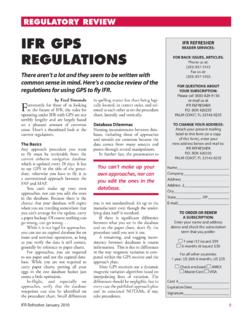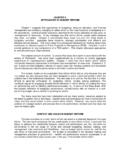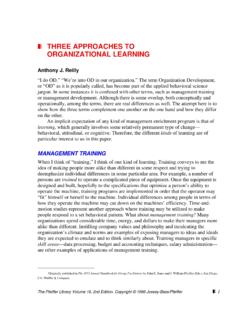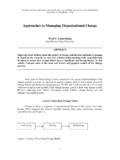Transcription of GPS APPROACHES DISSECTED - Instrument Flight …
1 IFR Refresher February 2010 APPROACH ClINICThis is native behavior for a GPS. If you are off your enroute course, GPS mea-sures it as a cross-track error. GPS APPROACHES DISSECTEDDo you know the difference between an LNAV and an LPV? Lots has changed in the past five years. Here s a review. by Fred SimondsMy student looks at me, perplexed by the embarrassment of riches presented on a GPS approach plate:.There are three possibilities, all start-ing with L, Which approach are we doing? Our choices have multiplied in the last few years so now LNAV, LNAV/VNAV and LPV allow as many GPS approach-capable aircraft to use them as possible, and provide they a non-WAAS backup LNAV approach if WAAS isn t available.
2 Let s review the current state of GPS APPROACHES . Bread-and-Butter LNAVThe simplest GPS approach is the LNAV, or lateral navigation approach. Representing 53 percent of all GPS APPROACHES , there were 4492 published as of this writing. It s a nonprecision approach that requires only a non-WAAS IFR GPS receiver and it offers no glideslope information. Even so, it s more precise and stable than a VOR approach, offering 66-foot horizontal accuracy. You fly it in the classic way: descend at a desired rate, the chop and drop, to MDA, then land or APPROACHES have a fairly wide trapezoidal 2-mile obstacle clearance surface at the FAF, narrowing to 1 mile at the runway threshold.
3 Since the obstacle clearance surface area is larger than other GPS APPROACHES , obstacles often force higher MDAs, typically 400 feet AGL. LNAV APPROACHES are subtly unique in their use of linear course guidance. This means that a deviation from the desired ground track is shown as distance. Accordingly, if you flew an LNAV approach consistently 300 feet to the right, the course deviation indicator would remain deflected to the left, and you could wave out your window at the runway going by a foot-ball field is native behavior for a GPS. If you are off your enroute course, GPS measures it as cross-track error: miles for non-WAAS full-scale devia-tion and 1 mile if of us are more familiar with angular course guidance, because this is how VORs and localizers operate.
4 Angular guidance measures devia-tions from desired ground track in degrees. An aircraft will approach the desired track if the angular error from it remains constant. All other WAAS APPROACHES use angular IntegrityOn any GPS approach, the satellite constellation must permit an accuracy of mile full scale from the FAF to the MAP. For LNAVs, the receiver typically does a RAIM integrity check about 2 miles before the FAF and warns you if the accuracy is insuf-ficient. If a RAIM warning occurs after the FAF, the receiver is supposed to continue operating for five minutes to allow you to complete the approach, but I have heard that some GPS receiv-ers freeze instead.
5 It makes sense to know ahead of time how your receiver will react so check your manual. Occasionally LNAV minima are lower than LNAV/VNAV minima. This can be due to a quirk in the TERPS approach design criteria, per-haps an obstacle sticking up into a potential glidepath near the runway. Accordingly, the LNAV planview may specify a safe stepdown fix to get past it, hence the lower you need LNAV minima in order to land, you may be able to quickly load and activate the LNAV approach instead of LNAV/VNAV. Near or past the FAF this may not be possible. Alternatively, you can fly an LNAV/VNAV approach down to the LNAV MDA. You can do this safely because the lateral limits of an LNAV and LNAV and LNAV+V APPROACHES use linear course guidance.
6 The obstacle clearance area narrows from 4 nm at the FAF to 2 nm at the MAP. It is the same size for LNAV, LNAV+V and LNAV/VNAV Refresher February 20108 APPROACH ClINICLNAV/VNAV APPROACHES are identi-cal. You can even fly the glidepath as long as you stop descending at the LNAV Approach AccuracyWAAS improves GPS signal accu-racy from 20m to about 2m both horizontally and vertically and makes APPROACHES with vertical guidance, or APVs, possible. Today these include LNAV/VNAV and LPV APPROACHES . Thus far, the FAA has published 3887 WAAS APPROACHES , 54 percent of all GPS APPROACHES and 44 percent of its goal of about can easily recognize an APV on the plate because it has a DA; a nonprecision approach has an MDA.
7 Your WAAS receiver constantly monitors and anticipates horizontal and vertical protection limits (HPL and VPL). Statistically, there is only a one-in-100 million chance that the GPS will be in error by more than either the HPL or receiver permits only approach-es meeting required accuracy levels. For instance, an LPV approach with a 200-ft DH has a 35-meter VPL. WAAS specifications call for you to be warned within seconds of any loss of signal integrity, much sooner than an ILS whose monitors trigger at 10 seconds or more. Near the ground, seconds mean a of SignalIf the WAAS signal is lost, the glide path vertical deviation indicator dis-play disappears and you revert to using LNAV minima instead, just like losing the glide slope on an the final approach fix, GPS receivers indicate their approach mode.
8 In the G1000 on an LPV approach, a yellow background warns you if either or both the VPL and HPL are not met, and that you may be facing a down-grade in approach type. If an APR DOWNGRADE alert appears, you must then use LNAV minima. A more severe message, ABORT APPROACH LOSS OF NAVIGATION calls for a missed approach and possible reversion to VOR navigation. LNAV+V Today the FAA looks at the nonpre-cision dive-and-drive maneuver as an invitation to a CFIT accident. It s one thing to do it in training, but the com-bination of low altitude and airspeed while looking for the runway in IMC has proven deadly. Statistically, you are about five times more likely to have a CFIT acci-dent on a nonprecision approach than on one with vertical guidance.
9 Until the LNAV+V, only an ILS glide slope offered vertical earliest form of GPS approach with vertical guidance was a Jeppesen creation called LNAV+VNAV, often abbreviated as LNAV+V. You read this properly as an above-described LNAV approach but with a big caveat: the vertical guidance is advisory-only and does not guarantee obstacle clearance. Some pilots limit their use of the LNAV+V to conditions where the ceilings are high enough to permit a visual approach to the advisory glide path offers ver-tical guidance from the FAF to the runway touchdown point. It offers a stabilized approach and eliminates the potentially deadly chop-and-drop .Artificially derived from WAAS signals, the vertical component of LNAV+V is not officially sanctioned by the FAA, which is why you won t see LNAV+V on an approach plate.
10 There is no way to know before Flight whether an LNAV+V will be available. The best you can do is see what choices your gear offers you when you go to load an only circling minima are pub-lished or if the approach course is misaligned more than 30 with any runway heading, no vertical advisory guidance will be +V APPROACHES use LNAV minima. An LNAV+V approach is NOT an APV as is the similar-sound-ing LNAV/VNAV and LPV approach-es which do assure obstacle navigation with vertical nav-igation to the surface is abbreviat-ed LNAV/VNAV or L/VNAV. In December, 2009 there were 1957 APPROACHES of this type-about 23 per-cent of the APPROACHES have the same 556 meter lateral limit as an LNAV approach, but offer true WAAS verti-cal guidance.







